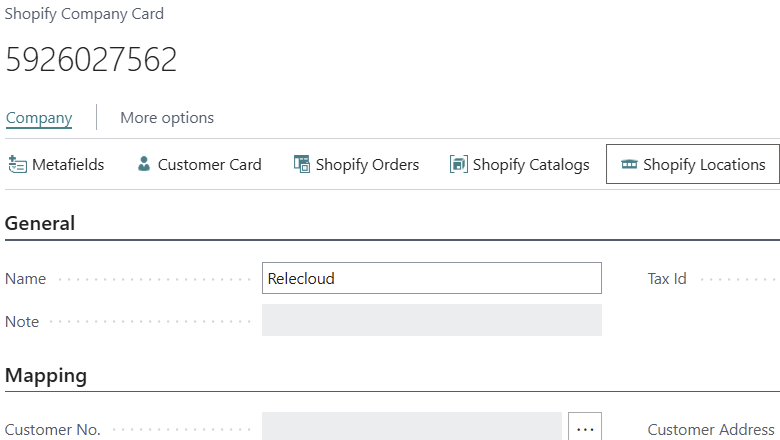 This post is part of the New Functionality In Microsoft Dynamics 365 Business Central 2025 Wave 1 series in which I am taking a look at the new functionality introduced in Microsoft Dynamics 365 Business Central 2025 Wave 1.
This post is part of the New Functionality In Microsoft Dynamics 365 Business Central 2025 Wave 1 series in which I am taking a look at the new functionality introduced in Microsoft Dynamics 365 Business Central 2025 Wave 1.
The 15th of the new functionality in the E-commerce section is import and export more data for Shopify B2B companies and company locations.
To enhance e-commerce efficiency and reliability, Microsoft have expanded the amount of information Shopify and Business Central can exchange in B2B scenarios. The Shopify Connector now imports all company locations, including payment terms and tax IDs, which it can use for automatic entity mapping. When exporting data to Shopify, the tax ID, company ID, and company/attention details are included in the sync to improve order information and traceability. The automatic creation of catalogs now ensures consistent pricing across both Shopify and Business Central.
Enabled for: Users, automatically
Public Preview: –
General Availability: Apr 2025
Feature Details
Microsoft have improved how they handle company details for B2B scenarios. Microsoft continue to enhance the integration between Shopify and Business Central, aiming to provide exceptional service to your B2B customers.
When you import a company from Shopify, you also import all of its locations, which you can access on the Shopify Locations page. You can open the page from the Shopify Companies and Shopify Company Card pages.
The first imported location is used to create the customer and add address information and other fields on the customer card. The location is marked as the Default. When you export a customer as a Shopify company, the Shopify Connector creates one company location. In Business Central, this location is marked as the Default.
The Company Location feature in Shopify allows merchants to define default payment terms. When you export customer information as a Shopify company, payment term details transfer to Shopify and are stored in the default company location if:
- The Payment Term field in the Customer Card contains a value.
- A corresponding record is located in the Shopify Payment Terms Mapping page.
When you import a Shopify company, you can see associated payment terms for each company location. If the Shopify Connector is configured to update the customer, it uses the payment term from the default location. It’s important that the corresponding record exists on the Shopify Payment Terms Mapping page.
In Shopify, each company location can have a tax ID. When you export a customer as a Shopify company, the tax ID is stored in the default company location. The new Company Tax ID Mapping field on the Shopify Shop Card page lets you choose to send either the Registration Number or the VAT Registration No. as the tax ID.
When you import Shopify companies, the tax ID at the default Shopify Location helps map imported companies to existing customers. Select By Tax ID in the Company Mapping Type field on the Shopify Shop Card page to activate the mapping logic.
The latest release of the Shopify connector introduced individual prices and discounts, which complement the global and customer price group/customer discount group pricing structures. These individual prices and discounts provide greater flexibility and personalization for B2B customers, and Microsoft have taken that even further.
When you export a customer as a Shopify company, if you configured the Shopify Connector to create a catalog, the Customer No. field is filled in for the catalog. This enhancement ensures that the connector uses the specific customer to calculate prices, eliminating the need to fill in the Customer Price Group, Customer Discount Group, and Allow Line Discount fields. You just need to turn on the Sync Prices toggle and select Sync Prices to start synchronizing catalog prices so that your customers get consistent pricing in Shopify and Business Central.
When you export a customer as a Shopify company, the Company ID is filled in with the value in the No. field from the Customer Card page, which enhances traceability. Also, the Shopify Connector fills in the Company/Attention field in the created company location with the company name. The name is used in imported orders.
Click to show/hide the New Functionality In Microsoft Dynamics 365 Business Central 2025 Wave 1 Series Index
Microsoft Dynamics 365 Business Central 2025 Wave 1
What should we write about next?
If there is a topic which fits the typical ones of this site, which you would like to see me write about, please use the form, below, to submit your idea.






